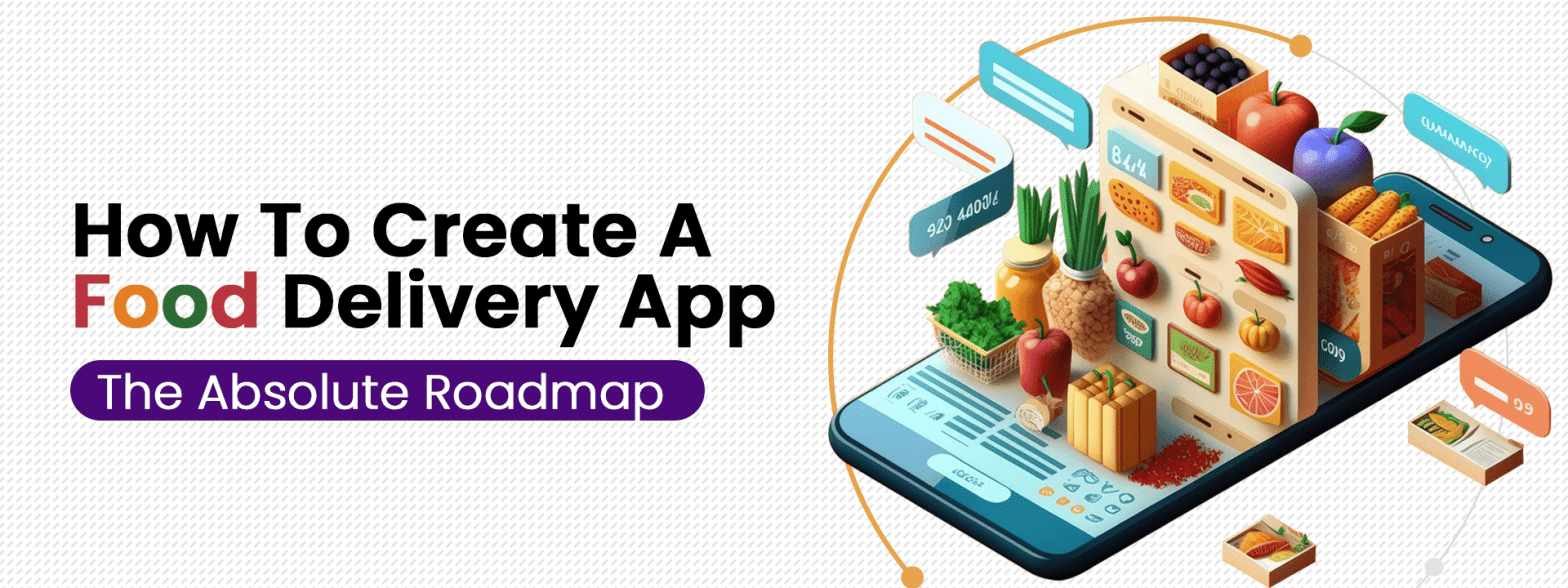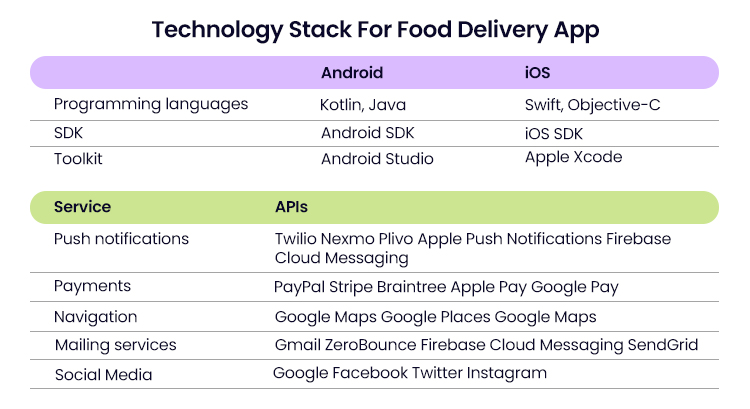
How To Create A Food Delivery App: The Absolute Roadmap
![]() Vishal Malik
Vishal Malik
Published: 29 Jun, 2023
The food delivery app development industry is experiencing unprecedented growth, fueled by the increasing demand for delivered meals amidst the ongoing pandemic. This rapidly expanding market presents a lucrative opportunity for businesses in this sector.
Table of contents
2. Food Ordering App Development: Three Revenue Models
3. Key Features of the Food Delivery App
4. Technology Stack for Food Delivery App
5. Seven Steps to Develop and Launch a Powerful Food Delivery App
6. Seven Security and Trust Processes in Food Delivery App Development
7. Future Trends in Food Delivery App Solutions
7. Conclusion
Market Analysis
According to Business of Apps, the United States alone has witnessed a staggering rise in food delivery app users, reaching 111 million in 2020. This number is expected to continue its upward trajectory. In terms of revenue, the market is projected to grow at an impressive annual rate of 9.89 percent (CAGR 2021-2025), reaching a market volume of US$441,622 million by 2025.
The surge in online meal purchases has been remarkable, with the number of individuals ordering meals online nearly quadrupling in the past three years, jumping from 364.8 million in 2017 to 625.9 million in 2020. As a result of this phenomenal growth, there has been a corresponding increase in the emergence of the food delivery business through custom mobile app solutions.
Food Ordering App Development: Three Revenue Models
Food delivery applications can support a single restaurant or many restaurants, cafes, and fast food. The application will have different components and a app development lifecycle process depending on your chosen type.
There are three categories of food business models
1. Aggregators with logistics
2. Aggregators without logistics
3. Hybrid food delivery solutions
Aggregators With Logistics
This business model involves creating a platform as a middleman between customers and restaurants. The aggregator takes customer orders through their app or website and then passes them on to the partnered restaurants. They also handle the delivery logistics by employing their fleet of delivery drivers or partnering with third-party delivery services. The aggregator earns revenue by charging a commission fee from the restaurants for each order or by adding a markup on the menu prices.
Key Components
- User-facing mobile app or website for customers to browse and place orders.
- Restaurant-facing app or web portal for managing menus, orders, and tracking sales.
- Delivery driver app for managing delivery logistics and tracking orders.
- Payment gateway integration for secure online payments.
- Rating and review system to maintain quality control.
Aggregators Without Logistics
In this model, the aggregator acts as a platform connecting customers and restaurants, but they must handle the delivery logistics themselves. Instead, they rely on the partnered restaurants to manage the delivery or outsource it to third-party delivery services. The aggregator provides a user-friendly platform for customers to discover restaurants, place orders, and make payments. The revenue generates through commission fees or menu markup, similar to the previous model.
Key Components
- User-facing mobile app or website for browsing restaurants and placing orders.
- Restaurant-facing app or web portal for managing orders and menus.
- Payment gateway integration for online payments.
- Rating and review system for feedback and quality control.
Hybrid Food Delivery Solutions
This model combines the features of both aggregator models. The aggregator develops its fleet of delivery drivers to handle logistics for some partnered restaurants, while for others, they rely on the restaurants’ in-house delivery or third-party services. This hybrid approach gives the aggregator more control over the delivery process and ensures a better customer experience. The revenue generation methods remain the same through commission fees or menu markup.
Key Components
- User-facing mobile app or website for ordering and delivery tracking.
- Restaurant-facing app or web portal for managing orders and menus.
- Delivery driver app for managing logistics and tracking deliveries.
- Payment gateway integration for online payments.
- Rating and review system for feedback and quality control.
The choice of model will depend on factors such as available resources, market competition, and desired level of control over the delivery process.
Key Features of the Food Delivery App
Implement a tracking feature that allows users to track their orders in real time, providing updates on their delivery status from restaurant preparation to doorstep arrival.
Food Delivery App Features for Customers
Food delivery app features for customers typically include the following:
- User Registration and Profile
- Restaurant Listings and Menus
- Search and Filters
- Ordering and Customization
- Secure Payments
- Real-Time Order Tracking
- Order History and Favorites
- Ratings and Reviews
- Customer Support
- Promotions and Discounts
Food Delivery App Features for Restaurants
Food delivery app features for restaurants typically include the following:
- Restaurant Registration and Profile
- Menu Management
- Order Management
- Preparation Time and Capacity Management
- Inventory Management
- Order Notification and Confirmation
- Payment and Settlement
- Customer Feedback and Reviews
- Analytics and Reporting
- Promotion and Marketing
Food Delivery Application Features for Couriers
Food delivery app features for couriers typically include the following:
- Courier Registration and Profile
- Order Assignment and Acceptance
- Real-Time Order Tracking
- Route Optimization
- In-App Communication
- Proof of Delivery
- Earnings and Payout Management
- Availability Management
- Performance and Ratings
- Support and Assistance
Food Delivery Application Features For Admin Panel
Food delivery app features for admin panel typically include the following:
- Dashboard
- Restaurant Management
- Menu and Category Management
- Order Management
- User Management
- Delivery Fleet Management
- Payment and Settlement
- Analytics and Reporting
- Promotions and Marketing
- Support and Assistance
- System Settings and Configuration
Technology Stack for Food Delivery App

In addition, integration APIs are needed for various restaurants, delivery services, and other third-party providers to enhance the functionality of food delivery apps. The selection of technologies depends on the specific type of application you plan to develop, your target audience, and the chosen business model.
Seven Steps to Develop and Launch a Powerful Food Delivery App
Best App Model Provision
We provide a prebuilt version of the food delivery app with updated features to meet the current market demands.
Up-to-Date Technology Coverage
Implement existing technologies like social media log-in, real-time data collection, instant alerts, multitasking capabilities, and multiple payment modes to enhance the productivity of your app.
Attractive UI/UX Design
The prebuilt app model has an appealing user interface and can be customized according to your business preferences.
Fully Customizable Solution
We offer a fully customizable app solution, allowing you to add or remove features per your business requirements.
Secure Data Storage
All data transactions within the app are encrypted, ensuring secure communication between users and protecting sensitive information.
Full Team Guidance and Support
We provide expert and technical support to help you navigate the app development process and succeed in your chosen field.
Cost-Effective Product Output
With the prebuilt app model, you can develop your food delivery app at an affordable price without compromising functionality and effectiveness.
By following these steps, We aim to assist entrepreneurs in launching a reputable and successful food delivery business in the competitive market.
Seven Security and Trust Processes That We Follow While We develop your Food Delivery App
Secure Authentication
Implement a robust authentication system to ensure only authorized users can access the app. Use strong password requirements and support additional authentication methods like two-factor (2FA) to enhance security.
Secure Payment Processing
Partner with trusted, secure payment gateways to handle online transactions. Implement encryption protocols (SSL/TLS) to secure sensitive user information during payment processing and ensure compliance with Payment Card Industry Data Security Standard (PCI DSS) requirements.
Data Protection and Privacy
Implement measures to safeguard user data, including personal information, payment details, and order history. Follow best practices for data encryption, secure storage, and secure data transmission. Communicate the app’s privacy policy to users and obtain their consent for data collection and usage.
Adhere to relevant data protection and privacy regulations, such as the General Data Protection Regulation (GDPR) or local data protection laws.
Vulnerability Testing and Penetration Testing
Regularly conduct comprehensive security audits, vulnerability assessments, and penetration tests to identify and address the app’s potential security weaknesses and vulnerabilities. This helps in proactively detecting and mitigating security risks.
Secure API Integrations
When integrating with third-party services, ensure that the APIs are safe and follow industry-standard security protocols. Implement proper authentication and authorization mechanisms to prevent unauthorized access to APIs and sensitive data.
Compliance with Privacy Regulations
We adhere to relevant data protection and privacy regulations, such as GDPR (General Data Protection Regulation) or CCPA (California Consumer Privacy Act), to safeguard user privacy and ensure legal compliance.
Secure Communication
We use secure protocols like HTTPS to establish encrypted connections between the app, server, and other third-party services. This protects against data interception and ensures the integrity of data transmission.
Future Trends in Food Delivery App Solutions
- Integration of Emerging Technologies Like AI
- Contactless Delivery and Smart Lockers
- Hyperlocal Delivery Networks
- Sustainable and Eco-Friendly Practices
- Personalized Nutrition and Dietary Requirements
- Voice Recognition and Natural Language Processing
- Virtual Kitchen and Ghost Restaurants solutions
Conclusion
With the meal delivery industry booming and online ordering becoming increasingly popular, now is the perfect time to launch a food & grocery delivery app that caters to these trends. Our team specializes in developing user-friendly custom mobile app solutions that prioritize convenience and utility for users.
When it comes to the cost of mobile app development, it can vary based on factors such as the specific features you choose, the platform you intend to build the app on, and the inclusion of advanced functionalities. As a food delivery app development company, we possess the expertise to leverage the latest trends and technologies to create a robust app for your business.
We invite you to share your thoughts and explore a demo of our services. We are committed to helping you tap into the vast potential of the food delivery market by leveraging our expertise in app development.
Copyright © 2023 NetMaxims Technologies Pvt. Ltd.
All Rights Reserved














